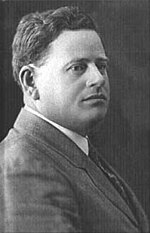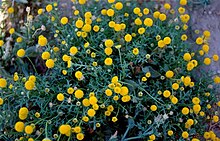Aaron Aaronsohn
Aaron Aaronsohn | |
|---|---|
 | |
| Born | 1876 |
| Died | 15 May 1919 |
| Scientific career | |
| Fields | Botany |
| Author abbrev. (botany) | Aarons. |
Aaron Aaronsohn (Hebrew: אהרון אהרנסון) (1876 - 15 May 1919) was a Jewish agronomist, botanist, and Zionist activist. Aaronsohn was the discoverer of wild emmer (Triticum dicoccoides), believed to be "the mother of wheat."[1]
Biography
Aaron Aaronsohn was born in Bacău, Romania, and brought to Palestine, then part of the Turkish Ottoman Empire, at the age of six, when his parents were among the founders of Zichron Yaakov, one of the pioneer Jewish agricultural settlements of the First Aliyah.
After his study in France, sponsored by Baron Edmond de Rothschild, Aaron Aaronsohn botanically mapped Palestine and its surroundings and became a leading expert on the subject. On his 1906 field trip to Mount Hermon, he discovered Triticum dicoccoides, an important find for agronomists and historians of human civilization.[2] It made him world-famous and, on a trip to the United States, he was able to secure financial backing for a research station established in Atlit in 1909. He built up a large collection of geological and botanical samples there and established a library.[3] Aaronsohn served as a scientific consultant to Djemal Pasha during a crop-destroying desert locust invasion in 1915.[4] In March–October 1915, a plague of locusts stripped the country of almost all vegetation.[5]
Aaronsohn was the founder and head of Nili, a ring of Jewish residents of Palestine who spied for Britain during World War I. he recommended the plan of attack through Beersheva that General Allenby ultimately used to take Jerusalem in December 1917. Owing to information supplied by Nili to the British Army concerning the locations of oases in the desert, General Edmund Allenby was able to mount a surprise attack on Beersheba, unexpectedly bypassing strong Ottoman defenses in Gaza.[6] After the war, Chaim Weizmann called Aaronsohn to work on the Versailles Peace Conference. On May 15, 1919, Aaronsohn was killed in an airplane crash over the English Channel in unclear circumstances. Some blamed the British government.[7] His research on Eretz Israel and Transjordan flora, as well as part of his exploration diaries, were published posthumously.
Published works

- Agricultural and botanical explorations in Palestine, 1910
- Reliquiae Aaronsohnianae, 1940
See also
References
- ^ Molecular Genetic Maps in Wild Emmer Wheat
- ^ Molecular Genetic Maps in Wild Emmer Wheat
- ^ Biography of Aaron Aaronsohn
- ^ Lawrence and Aaronsohn: T. E. Lawrence, Aaron Aaronsohn, and the Seeds of the Arab-Israeli Conflict, Ronald Florence
- ^ The Locust Plague
- ^ Lawrence and Aaronsohn: T. E. Lawrence, Aaron Aaronsohn, and the Seeds of the Arab-Israeli Conflict, Ronald Florence
- ^ The Aaronsohn Saga
- ^ International Plant Names Index. Aarons.
Further reading
- Ronald Florence, Lawrence and Aaronsohn: T. E. Lawrence, Aaron Aaronsohn, and the Seeds of the Arab-Israeli Conflict, 2007, Viking Adult, ISBN 978-0-670-06351-2.
- Chaim Herzog, Heroes of Israel, 1989, Little Brown and Company, Boston ISBN 0-316-35901-7
- Goldstone, Patricia. Aaronsohn's Maps: The Untold Story of the Man Who Might Have Created Peace in the Middle East. San Diego: Harcourt, 2007.
- Shmuel Katz, The Aaronsohn Saga, 2007, Gefen Publishing House, Jerusalem ISBN 978-965-229-416-6

